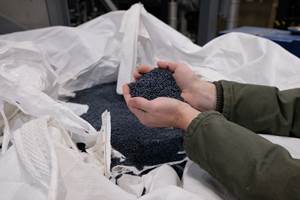Building a Future With Sustainable Compounds
With roots in recycling, Star Plastics produces engineering thermoplastic compounds to meet performance and environmental goals.
Manufacturers turn to engineering resins when high performance, flame retardance or robustness to harsh environments are required. Star Plastics meets these needs with its custom compounds, which include ABS, nylon and PC materials. Some 36 years of progressive growth in the plastics industry bear witness to the company’s success and consistent quality of its products. But if you walk the halls of the company’s newly renovated West Virginia offices, you won’t get far without hearing the words “continuous improvement.”

Left to Right: Star Plastics’ CEO Dan McMullen, Sales Director Rick Addis, Marketing Communications Leader Scott Blanchard, and Technical Manager Bob Powers. Source: Alfredo Peters.
Star’s improvement programs use the DMAIC method. “We Define a project, we Measure the performance of that process, we Analyze data and implement Improvements, and then we have Controls to make sure that the progress and improvements have stayed,” says Sonja Butler, who champions continuous improvement activities at Star Plastics.
The DMAIC approach, part of the Six Sigma methodology, was developed by Motorola in 1986 and spread across the world as a paradigm for making data-driven decisions. Star Plastics has 2 certified black belts, 2 green belts, and 16 staff members working toward their yellow belt certification. Butler herself is working to achieve black belt status this year.
“Our continuous improvement projects fall into two categories. We have the quick hits, you get an idea, people embrace it and you move on. Then we have the longer term DMAIC-type projects, that take a little more time and effort to resolve, but they all pay dividends at the end of the day,” explains Dan McMullen, CEO. “They’ve made us more competitive, and a better supplier.”
One new initiative showing results is the incentive investment program, which gives Star employees a personal stake in efficiency gains. Star monitors production rate, scrap, rerun and uptime. Depending on the line, there are different targets to hit. Updates are given monthly and progress is posted at the lines. Quarterly bonuses are based on the targets achieved.
According to McMullen, the program has production staff engaged. “I’ll hear people in the cafeteria talking about ‘I got this rate on this tool, with this material.’ So not only do they see the gain in their bonus pay but there is a real sense of pride.”
Roots in Recycling
Star Plastics was founded as SDR plastics in 1988 by 27-year-old Doug Ritchie. Ritchie started with a contract to recycle scrap from a nearby Borg Warner plant. Throughout the 1990s, the company expanded into custom compounding. In 1996, the company started selling its own products and adopted the name Star Plastics. The following year, Star acquired a second plant in nearby Millwood and divided its feedstock preparation and compounding operations.

Mike Moran, Star Plastics’ environmental health & safety director, explains how the company reworks its own material, such as this box of head scrap
When, in the late 2000s, the federal government implemented the Electronic Product Environmental Assessment Tool (EPEAT), it gave OEMs a competitive incentive to use recycled materials. Star became a supplier to Lenovo, helping to bring about some of the first computers made with recycled materials.
“Our expertise at Star Plastics has always been being able to take recycled materials, modify them and formulate something that is a prime-performing product,” Ritchie says, now serving as vice president of corporate strategy.
Capital Investments Boost Output
Star Plastics was acquired by Akoya Capital in 2021, and new investments in the business have included renovations, processing equipment and upgrades to the company’s laboratory testing equipment.
These improvements have raised the bar in terms of the levels of efficiency Star can achieve. Twin screw extruders from Coperion and Leistriz have improved flexibility, repeatability and increased capacity fourfold, compared with the previous single-screw lines. An elevator spiral track from Vibrowest enables high throughput by cooling and drying material after pelletization , preventing clumping.

High throughput requires carefully planned conveying and heat management. On this line, a spiral elevator cools and dries newly formed pellets before they are boxed, preventing clumping.
Material handling systems have also been an important part of the company’s programs to run efficiently, safely and clean. The integrated network of overhead ducts feeds drying, blending and processing operations, minimizing manual material management and keeping the space clean and efficient. The Millwood facility also has a railway spur, with ducts immediately adjacent to the line to facilitate bulk offloading, which can also be used for loading when the need arises.
Third-Party Certifications Establish Confidence
Star Plastics’s Ravenswood lab is charged with testing to develop custom compounds and validate them to the customer’s requirements. The prework extruder produces 5-lb test batches before moving a material formulation to production. A new Kerke 20-mm extruder is being implemented in this role, replacing an older system. A second extruder with a special mixing screw is for R&D and color matching. Finally, a third extruder with a screw design that matches the production screws is used to make final tests before scaling up. Five injection molding machines make test samples for mechanical and other testing.
Test samples are evaluated for color, environmental resistance, tensile and flexural strength, impact toughness, softening and heat deflection temperature, and more to ensure the demands of the customer’s application are met.
Another important customer requirement is UL listing. As a compounder of engineering plastics such as ABS, nylon and polycarbonate (PC), many of Star’s customers manufacture electrical components such as wall boxes and business equipment. Gaining and maintaining UL listing, which defines the applications for which a material can safely be used, is critical. “UL is important whether you’re a billion-dollar company or a consumer buying supplies for a home remodel,” says Rick Addis, director of sales.
Star has dozens of products with UL listings, with flammability ratings from V0 to 5VA, and customizes them for customer needs by adjusting color, melt index and Izod toughness. Star’s testing capabilities support certification by enabling consistent control of production quality and clear demonstration of that control.

Star Plastics customizes properties, including color, to meet its customers’ requirements.
Building a Future With Sustainable Compounds
Star Plastics’ Renova product line, which incorporates recycled materials, requires some extra steps. To meet specifications, Star has to first establish the quality and properties of its incoming feedstocks. “We test every one of the loads coming in, just like we’re testing a finished good, every aspect of it,” says Bob Powers, technical manager at Star plastics.
Analytical testing in Star’s Millwood facility can include spectrophotometry, infrared spectroscopy, thermogravimetric analysis and differential scanning calorimetry. The lab determines that the correct product was delivered, and categorizes that product so that it can be appropriately classified before being introduced to a formula.
“We have certain ranges where we can adjust the formulation and still hit all the critical characteristics of the final product, so that’s where an in-depth evaluation of feedstocks comes in, to determine how we can utilize it,” Powers explains. So it’s really a close working relationship between sourcing and formulation.“

Star Plastics saw marked improvements in throughput and flexibility after upgrading its extrusion systems, a project that included this new twin screw line from Coperion.
Using recycled materials also requires traceability, and Star Plastics demonstrates this through another certification from UL. UL-E establishes that a chain of custody exists as evidence that supports recycled content claims made by a supplier. In engineering resins, postconsumer material is less available in North America, so pre-consumer materials are generally used, although Star has used postconsumer and has even sourced ocean-bound plastics.
In March, Star Plastics was awarded a “Good” rating by EcoVadis, an evaluation of sustainability measures that go beyond recycling and include measures such as carbon footprint, and can help Star’s customers improve their sustainability rating as well and gain ESG status.
Years of recycling experience enables the company’s staff to guide customers in their implementation. Sometimes, this might mean advising them to adjust their goals based on what is going to work for their application, even if that means using less recycled material. “Getting the right performance and properties are a must,” says Ritchie. “If we don’t get there at 50%, maybe we get there at 25, and we will guide them to where it does work.”
With roots in recycling, Star Plastics is positioned to meet the need for sustainable materials increasingly requested by OEMs, with validated recycled percentage content and properties of prime polymer. “The push for sustainability is huge. It continues to grow on a global basis and it is going to continue to get bigger,” says Chuck Hoop, business director.
Related Content
Looking to Run PCR on a Single Screw? Here’s What to Keep in Mind
Just drop it in and mix it up? Sorry, there’s a lot more to it than that. Here is some of what you need to consider.
Read MoreExtrusion Technology Extended to Injection, Enabling Up to 100% Regrind Usage
Twin-barrel (shot-pot) press can handle more regrind, offers other benefits to molders.
Read MoreFoam-Core Multilayer Blow Molding: How It’s Done
Learn here how to take advantage of new lightweighting and recycle utilization opportunities in consumer packaging, thanks to a collaboration of leaders in microcellular foaming and multilayer head design.
Read MoreNew Facility Refreshes Post-Consumer PP by Washing Out Additives, Contaminants
PureCycle prepares to scale up its novel solvent recycling approach as new facility nears completion.
Read MoreRead Next
Beyond Prototypes: 8 Ways the Plastics Industry Is Using 3D Printing
Plastics processors are finding applications for 3D printing around the plant and across the supply chain. Here are 8 examples to look for at NPE2024.
Read MoreMaking the Circular Economy a Reality
Driven by brand owner demands and new worldwide legislation, the entire supply chain is working toward the shift to circularity, with some evidence the circular economy has already begun.
Read More













